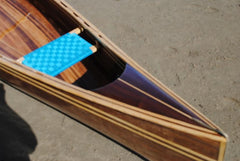Ripplin Waters: Keith Mathieson and Nicki Endt's Champlain

A few months ago, a beautifully printed book showed up in the Bear Mountain mailbox. It was a photo essay on the building of a Champlain canoe by Keith Mathieson, as chronicled by Nicki Endt. The canoe was beautiful and the story behind its making exceptional, and Keith and Nicki kindly agreed to let us share a part of that story here.
It begins on an anxious note, with Keith's diagnosis of renal cancer in 2008. After recovering from surgery and dialysis, he turned to making wooden surf boards and stand-up paddleboards. It was a relaxing pastime that piqued his interest in building a wooden canoe. The idea would have to be placed on hold when the cancer returned in 2012, setting back Keith's health and his hopes of receiving a transplant. Two years later, however, later he felt ready for a new project. He did some research and settled on a design: he would build the classic Champlain.

The Champlain is a traditional symmetrical design and more complex to build than some modern styles, but after speaking with us Keith decided he liked the Champlain's look, the performance specs suited him, and he was prepared for the challenges. He found some cedar that “had been siting in a bloke’s garage in Queensland for some years,” supplementing it with paulownia from his own supply. Progress was slow until a kidney transplant in 2016 set him on the road to recovery. A year later he was milling the cedar and paulownia himself, bundling the strips carefully to preserve the colour variations.
Nicki describes Keith as "keen to get stuck in." He made the strongback and cut out the molds, and planking proceeded quickly after that. Nicki describes him rigging up a means to bend the stems with a steam mop, in keeping with his habit of finding solutions that “frequently involved my household appliances.” Fortunately his experience with paddleboards had prepared him well for fibreglassing, and he rehearsed the process with Nicki carefully before they took the plunge.

“Resting in the cradle that Keith had made we could really appreciate the beautiful shape of the craft,” Nicki writes. Keith made the gunwales from mountain ash and the decks from jarrah. He made the yoke, seat frames, and paddles himself as well, and Nicki caned the seats.
They christened the finished canoe “Ripplin Waters,” and took their maiden voyage on a nearby lake. Nicki gave careful instructions to the cameraperson to capture the long-awaited moment. Then they promptly tipped the canoe in shallow water. It made for a playful start to the day, and Ripplin Waters has since been out for more expeditions with family and friends.
To us, Keith and Nicki's story combines a lot of factors that make canoe building meaningful. It was a long-gestating project that required collaboration with family - Nicki made several key contributions, and Keith's daughter had helped pick up the timber for most of the hull - and the project continues to pay dividends in multi-generational paddling trips. To have pulled that off with aplomb while coping with major health issues is real feat, and our hats are off to Keith and Nicki for making a fine and enduring canoe.









